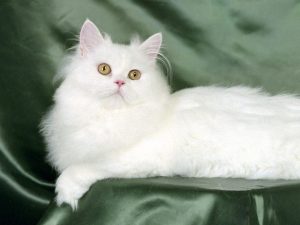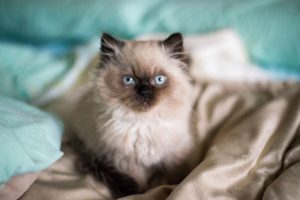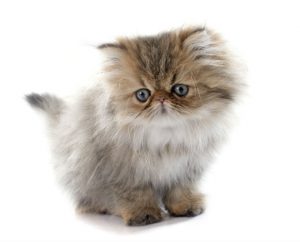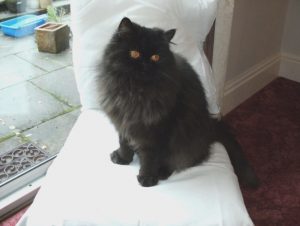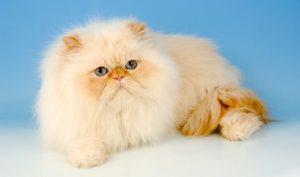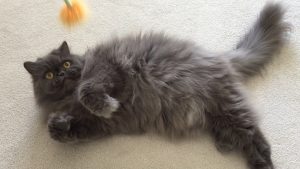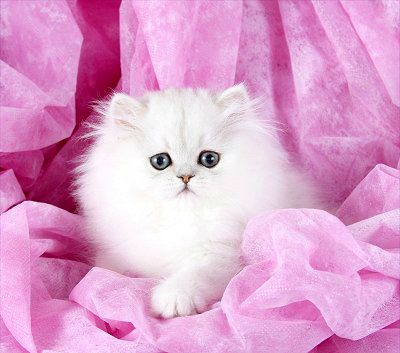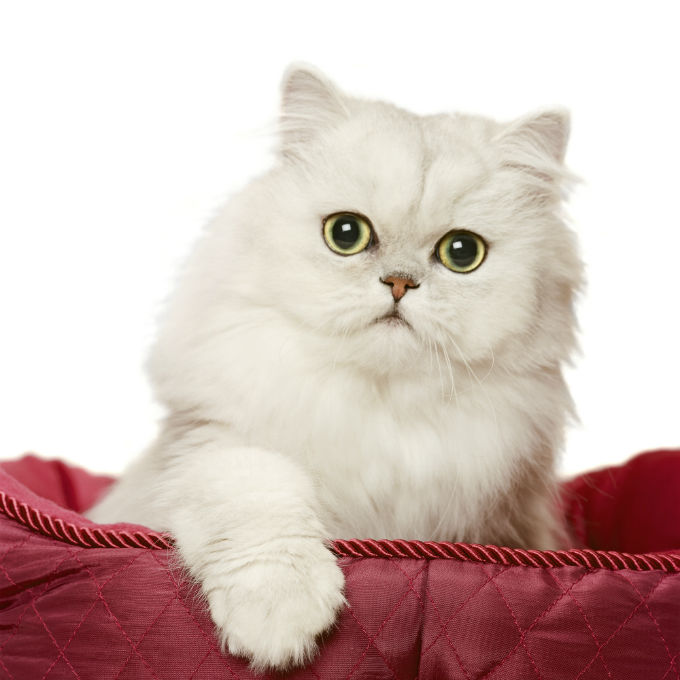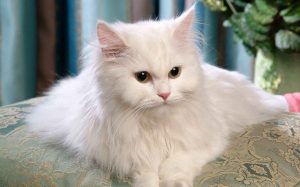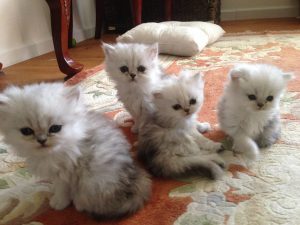Persian Cat
The gracious and glamorous Persian cat with its plush flowing coat, expressive eyes, intelligent demeanor and appealing personality has gained immense popularity in the present times. Introduced in the latter half of the 1800s, these long-haired cats developed in Iran.
Quick Information
Physical Appearance & Size
| Body Type: | Medium |
| Physical Appearance: | Well-muscled; short and stocky, round head, squarish body, huge, round-shaped eyes, snub nose, round chin, short legs and a thick tail |
| How Big do they Get (Size): | 9 to 14 pounds |
Colors & Patterns
| Coat Type: | Long, flowy, silky, glossy |
| Color: | Comes with a whole lot of color variations including white, gold, silver, bronze, lilac, red, fawn, cinnamon, chocolate, black, brown, ruddy |
| Eye Color: | Differs by the color of its coat. Common ones being copper, blue, odd-eyed ( blue and copper), green, bluish-green, hazel |
| Pattern: | According to CFA: Tabby (classic, patched, mackerel), particolored (tortoiseshell, chocolate tortoiseshell, lilac-cream, blue cream), bicolor (smoke and white; tabby and white), calico (black and red patches, while diluted calico has patches of blue and cream)According to TICA: Tabby (marbled, ticked, mackerel, spotted, classic); tortoiseshell |
Other Characteristics
| Other Names: | Shirazi, Iranian cat, Persian longhair |
| Average lifespan/ How Long do they Live: | 12-15 years |
| Litter Size: | 3 to 6 |
| Behavioral Characteristics: | Gentle, friendly, sweet, affectionate, adjustable, considerate |
| Lap Cat: | Yes |
| Shedding (Do they Shed): | High |
| Vocalization: | Soft |
| Good with Children: | Yes |
| Is it Hypoallergenic: | No |
| Country (Where do they come from): | Iran (Persia) |
| Competitive Registration/ Qualification: | CFA, TICA, FIFe, WCF, ACF, FFE, ACFA/CAA, GCCF, LOOF, CCA-AFC |
History and Origin
Named after the country in which they originated, the history of the breed remains unclear even in the present times. However, images of long-haired felines like the Persian cat appeared in hieroglyphics during 1684 B.C.
Cats imported from the Khorasan region of Iran is said to be the Persian cat’s first documented ancestor. In fact, their forefathers had been introduced to Italy and France by Pietro della Valle and Nicholas-Claude Fabri de Peiresc respectively. Long haired cats originating from Afghanistan, Persia, and Turkey were collectively known as Asiatic cats and even bred together.
After being imported to Europe, the long-haired breeds gradually rose to prominence. The Persian Cat was exhibited for the first time at the Crystal Palace, London for a cat show which had been organized by an Englishman named Harrison Weir.
There has been a mixed bag of opinion regarding the similarity between the Persian Cat and Turkish Angora since both of them were long-haired. However, several cat experts have established the difference between the two breeds regarding their physical traits. The Persians have a round head, wooly coat and short hair on the upper part of its hind legs. The Angora, on the other hand, possesses a wedge-shaped head along with a soft curly coat and long hair on its shoulder as well as hind legs.
Traditional vs. modern Persian cat
The traditional Persian cat (doll-face Persian) does not have the extreme features seen in the modern varieties of the breed.
During the 1950s ultra-type varieties like the peke-faced and flat-nosed Persian came into being, with its name inspired by the Pekingese dog. Though the CFA acknowledged it, their demand lessened in the middle part of the 1990s as such cats had a higher probability of facing health issues like breathing difficulties and teary eyes, thus only 98 of them registered from 1958-1995. In spite of the concerns associated with the modern variety, breeders still showed interest in developing the peke-faced varieties. The modern or ultra-type ones do well in shows, cat fanciers mostly prefer the traditional ones having a doll face, round head, small ears, big eyes and heavy bone structure.
Variants of the Persian cat
Himalayan: It was developed in 1950 crossing the Persian with the Siamese to create a breed which had the Persian’s body but the Siamese’s colorpoint pattern. Though regarded as a distinct breed in the US, the CFA finally merged it with the Persian cat.
Exotic Shorthair: The Persian was outcrossed with the American Shorthair for improving the standards of the latter. Named as the Exotic Shorthair, TICA recognizes them as a variant of the Persian while most other registries identify them as an individual breed.
Breeders have even attempted to produce smaller versions of the Persian cat, particularly the teacup and toy variations, with individual groups named as mini, pixie, pocket, and palm-sized. However, no registries have acknowledged or registered these kinds.
Temperament and Personality
- Sweet and gentle, mingling comfortably in a new environment.
- Like to dwell in places which are calm and quiet.
- Being peace-loving, they do not indulge in climbing on to bookcases and cupboard tops, instead prefer to remain confined to the ground.
- Has a soothing musical voice, though they do they mostly communicate through their expressive eyes and not vocally.
- Are affectionate but selective, enjoying the company of only its family members and a handful of trusted visitors.
- Loves to be cuddled by its owner and his family, though is not too demanding for their love and would be content to be petted at the convenience of the members.
- Enjoy the company of children provided the latter handle them in a kind and gentle way instead of indulging in a boisterous play.
- Gets along well with friendly cats as well as dogs who are kind to them.
Who is the Persian cat good for
- Families desiring for a well-behaved, gentle feline who would stay confined to one place rather than jumping around.
- Homes seeking for a perfect lap cat.
Care
The Persian cat has a long and dense coat which needs to be brushed on a regular basis using a metal comb to prevent any tangles and mats from forming. Other hygiene measures to be implemented include cleaning its ears and eyes using a damp cloth or cotton ball to keep any infections at bay. Bathing it on a regular basis is also essential to maintain cleanliness.
According to a pet insurance data provided by Sweden, felines of the Persian group have an average lifespan of over 12.5 years with 76% of them surviving till the age of 10 and 54% upto12.5 years or even more than that. The modern Persians may have breathing troubles as well as eye and skin problems because of their physical conformations. Other common issues that the Persian cat is likely to face include polycystic kidney disease, hypertrophic cardiomyopathy, progressive retinal atrophy, hip dysplasia, skin problems and gastrointestinal ailments.
Training
These gentle, courteous cats are a trainer’s delight as they would be obedient enough to listen to your commands as you get them ready for participating in shows. You can even train it to do exciting things like shake hands, dance or also use a leash. Positive reinforcements like rewards and praises are essential to encourage them.
Feeding
Good quality cat food is essential to keep your feline in good health. You can include homemade food in its diet too though in limited amounts. Avoid giving it table foods which are high in salt and spices.
Interesting Facts
- The CFA ranked it second regarding popularity in 2015 after the Exotic cats.
- The Persian cats have often been a painter’s delight, immortalized on the big canvas quite often.

